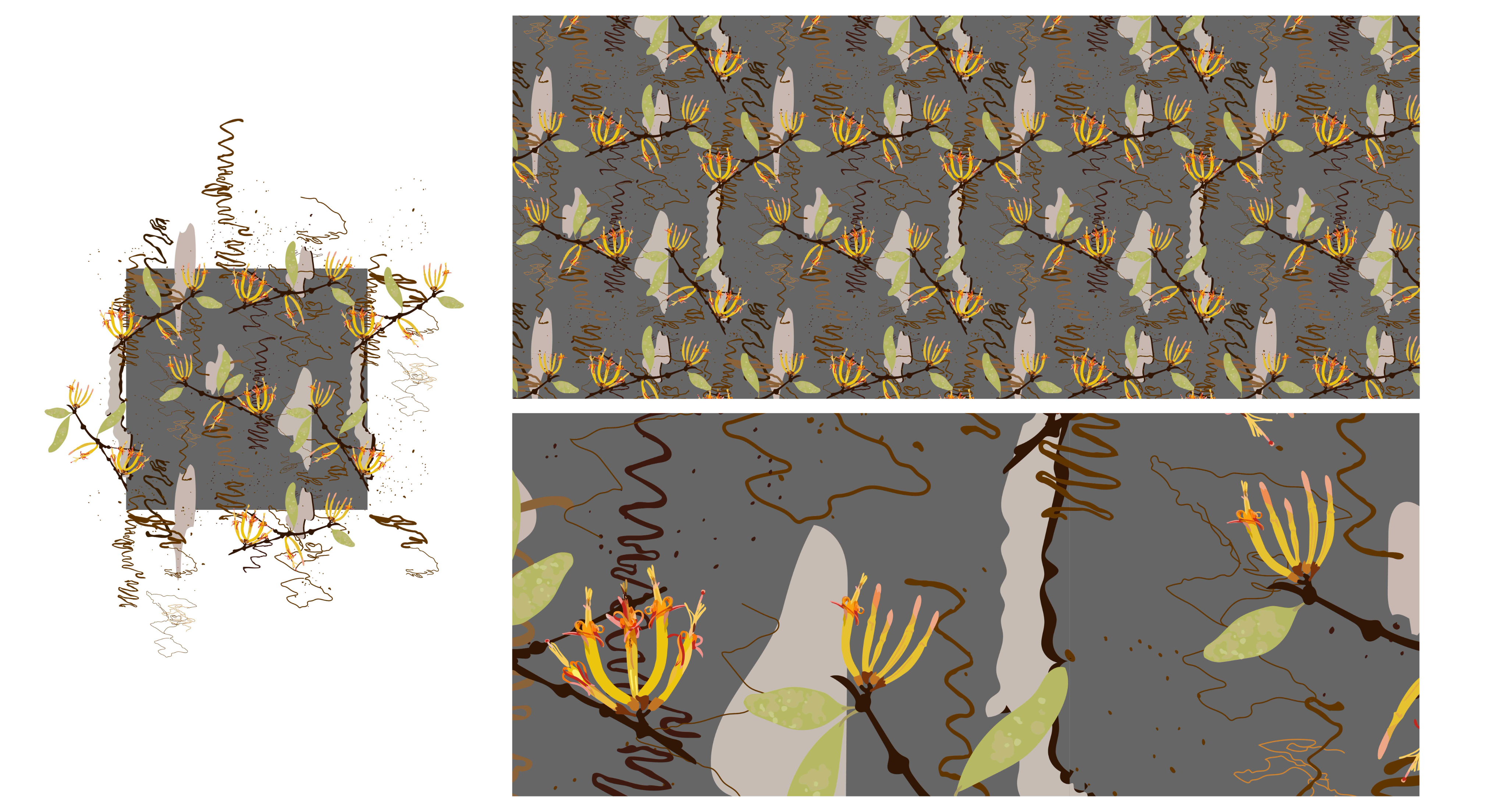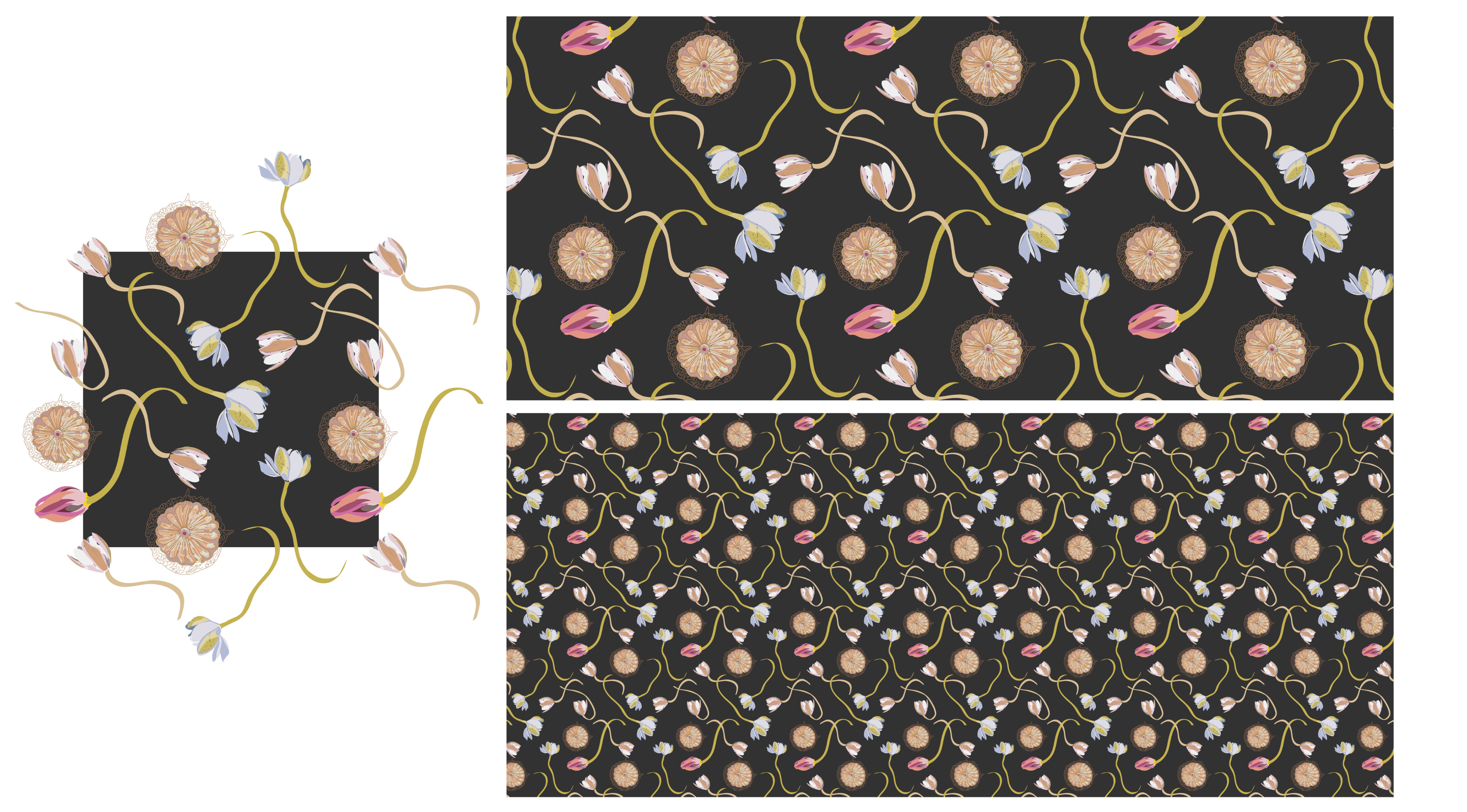
Rose Feely of Eucalypt Roses working in her Wurtulla Studio, 2020.
Revelling in the process of discovery, Rose Feely of Eucalypt Roses Design creates digitally drawn surface patterns that marry her love of botany and immersive art. While her designs follow a rich history of floral pattern design, Rose’s work invites viewers to look at remnant indigenous habitats with a sophisticated eye and compassionate heart.
 Mistletoe and host Scribbly Gum, 2021, hand drawn digital surface pattern.
Mistletoe and host Scribbly Gum, 2021, hand drawn digital surface pattern.
Each pattern tells a story of her beloved South East Queensland ecosystems, where she grew up and was based for the last 5 years. A pattern might feature symbiotic plants or plants that flower at the same time of year, or a flush of new growth following rain or fire. These patterns capture a moment in time, observing the flurries and relationships in our ecosystems’ seasonal cycles, honouring the complexity and profundity of Australia’s East Coast botanical biodiversity.
 Mooloolah River National Park after fire and rain. The national park on the Sunshine Coast was unseasonably burnt after fire ravaged 300 hectares of wet heath ecosystem.
Mooloolah River National Park after fire and rain. The national park on the Sunshine Coast was unseasonably burnt after fire ravaged 300 hectares of wet heath ecosystem.
Rose has also worked in plant production for nearly a decade propagating tropical ornamental plants, aquatic plants and now Australian native cut-flower species. She also supports environmental advocacy and the conservation of remnant bushland. In 2021 she spoke as a guest presenter on the value and techniques of habitat gardening alongside Ian Lowe at the Sunshine Coast Environment Council World Environment Day Festival and she also consulted with the Seljak sisters on the beach protest artwork “Eye of the Future”.
Through decorative design Rose hopes to contribute to a richer Australian identity and sense of place by appreciating pre-colonial ecosystems through observation and low-impact engagement.
We caught up with Rose to learn more about the integration of her horticultural and artistic journey to educate people about their local and native plants and ecosystems.

How does horticulture inform your artwork. Or what comes first?
Art, plants, pattern! I wasn't always a native plant fiend. During my time at art school I was intrigued by the human sensations of awe and amazement and studied how I might share these experiences within a white-walled space. I then discovered the richest experience of abundance and the sublime was actually to be experienced alone in a forest. So I moved away from the constructed gallery space and went to find out more about all these millions of captivating green skinned friends. Eventually, I discovered the science of pulsating ecosystems and finally found the ultimate immersive experience.
 Working between conservation and design, Rose's studio is always full of flowers, plant identification guides, conservation campaigns and dried botanical materials. Eucalypt Rose's studio, Buderim, 2022.
Working between conservation and design, Rose's studio is always full of flowers, plant identification guides, conservation campaigns and dried botanical materials. Eucalypt Rose's studio, Buderim, 2022.
I continued exploring printmaking techniques as I enjoyed its inherent repeat potential. Between printmaking and growing plants, I found myself swirling in the perfect combination of inspiration because patterns in nature exist at every scale and every colour. In an applied sense, patterns in wallpapers, fabric and architecture are designed to swallow you whole, like a forest. To immerse your physical body and disrupt your sense of space and scale, lighting up your sensory system, triggering emotions of grandeur and euphoria.
 Banksia Leaf Litter 2019. Hand pressed lino print on brown card. 115x135cm.
Banksia Leaf Litter 2019. Hand pressed lino print on brown card. 115x135cm.
Conservation became a really important part of my practice as I learned about the complexity of South East Queensland’s biodiversity and the threat it was under from changing land use. The designs I create contribute to a discussion around decolonising our urbanised spaces to support habitats for local flora and fauna.
 Eucalypts and Kangaroo Grass 2019. Hand pressed lino print on brown card. 115 x 115cm.
Eucalypts and Kangaroo Grass 2019. Hand pressed lino print on brown card. 115 x 115cm.
 Plant production patterns inspire Rose's wallpaper and fabric designs.
Plant production patterns inspire Rose's wallpaper and fabric designs.
There's a deliberate message underpinning my work. I'm introducing the visual language of underappreciated Australian native ecosystems into a long history of European floral pattern design. I want to familiarise people with the shapes and forms of our endemic plant species, nudging them to start a warm and fuzzy relationship with these forms. Hopefully, you'll begin to spot these plants on your commute to work or get excited when you visit a native plant nursery!
 Native Waterlily Flowers 2021, hand drawn digital surface pattern.
Native Waterlily Flowers 2021, hand drawn digital surface pattern.
At the Designing for Country event last year in Maroochydore Traditional Custodian of the Gubbi Gubbi/Kabi Kabi people Lyndon Davis aptly put it when he stated, "You have to know it to know how to take care of it."
You’ve recently moved to Greater Western Victoria. What's it been like moving to a new bio region?
Gardeners will understand what a drastic change it is to move climatic regions, I’m sure. When ecosystems are as familiar as your circle of friends, uprooting yourself from subtropical rainforest to arid temperate woodland is a big change! It wasn’t the people I was nervous about meeting, it was the vegetation communities or ‘bioregions’. Would they fill me with the same magical inspiration that wet heath does? Would the dry landscape explode with shapes and colours and life like the coastal foredunes do? Would they welcome me and let me open my heart to them like riparian creek zones do?
Thankfully the answer is yes. We’re still in the early days of our friendship but yes there is colour and life! Not the same colour palette, which is as exciting as it is daunting, but personalities abound and it is these eclectic compositions of shapes and colours I like to capture in my surface pattern design. Thankfully I had my old friend, the Seljak Pyramid blanket (inspired by various mountains of the Sunshine Coast), to comfort me in the transition between my previous life and my new life in a small country town. I’m constantly surveying the humming relationships between different flora and fauna and how this story might be told through pattern.
 Wimera Flat Lay, 2022.
Wimera Flat Lay, 2022.
This table flat-lay is down by a river where the local cockatoos put on a good sunset show, local kids enjoy a long rope swing and I sit and tinker with the forms and colours I find scattered on the ground. It was nourishing and comforting to have a piece of Seljak Brand’s creative energy there with me.
Your practice has evolved from Lino prints to digital prints. What does a digital format allow you to express?
Traditionally, surface pattern design was created using different printmaking techniques which unfortunately requires cumbersome printing machinery that is rarely accessible to an individual practitioner. I decided to ignore these limitations and began hand pressing prints on the biggest pieces of paper I could find. I never studied graphic design and wasn’t professionally trained to manufacture wallpaper that comes with huge minimum print requirements. That didn’t deter me though, as I love working with an artisan craft, spending days upon days carving shapes from the Lino mat. The moment you finish pressing the print and peel back the carved tile from the paper is called the ‘reveal’ and this sensation beautifully matches the euphoria I felt observing biodiversity.
 Growing Waterlilies, hand carved Lino print tile, 2020.
Growing Waterlilies, hand carved Lino print tile, 2020. 'Wildflowers' Lino Print series, Yaroomba Studio Sunshine Coast, 2019.
'Wildflowers' Lino Print series, Yaroomba Studio Sunshine Coast, 2019.
 'Wildflowers' Lino Print Series, hand pressed lino patterns on brown card, 2019.
'Wildflowers' Lino Print Series, hand pressed lino patterns on brown card, 2019.
Eventually, the potential of vectors (where the image created can be scaled to any size) lured me in and at the same time digital drawing technologies were becoming far more sophisticated and affordable.
 Ferns Regenerating 2021. Hand drawn digital surface pattern.
Ferns Regenerating 2021. Hand drawn digital surface pattern.
A standout advantage to the digital form of pattern design allows me to work quickly with a vast array of colours. Digital drawing technology responds really fluidly, allowing you to work on infinite scales while maintaining a hand-drawn quality. Being able to swap from colour to colour quickly and effortlessly has been a thrill.
 Lake Grass 2021. Hand drawn digital surface pattern
Lake Grass 2021. Hand drawn digital surface pattern
Soon my designs will be available as wallpapers and fabrics!
 Acacia and Hovea lino print hand pressed onto roller blinds, 2020.
Acacia and Hovea lino print hand pressed onto roller blinds, 2020.

